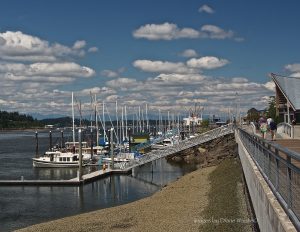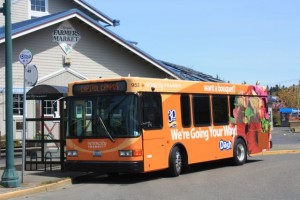Submitted by Thurston County Public Health & Social Services
We know that health is affected by a variety of community conditions, including environmental factors such as air and water quality. Climate – the long-term patterns of conditions such as precipitation and temperature – also affects us. Climate, by influencing how we live and what we’re exposed to, plays a role in our community’s health.
As our understanding of climate change grows, we learn more about potential health effects on communities. Among the changes predicted for Western Washington are:
- Drier, hotter summers with increased risk of heat waves and wildfires; this also

Drier, hotter summers are perfect for recreation and getting outdoors, but have bigger implications for our environment. Photo credit: Diane Waiste. worsens air quality (more particulate matter from fires, ground level ozone and pollen).
- Altered precipitation patterns, such as warmer (think rain rather than snow) and wetter winter months, with more frequent intense storms and resulting flood events.1
- Expanded territory for disease-carrying or disease-causing organisms such as mosquitoes that carry West Nile Virus, Hantavirus (carried by rodents) and Vibrio bacteria in shellfish.2
What can we do about this? Climate change from human activity is the result of many activities (agriculture, energy production and use, transportation, etc.) from all over world emitting gases that trap more heat in the lower atmosphere. While the ways we, the roughly quarter million Thurston County residents, live may be a small contribution overall, we do have an impact. The actions we take locally can reduce the emissions of greenhouse gases and result in health-related benefits to our community. Some of these actions include:
- Reducing local air pollution through energy conservation and switching to renewable fuels.
- Using active or mass transportation such as walking, bicycling and taking the bus.

Taking mass transit is a great option to help mitigate your impact on climate change. Walking and bicycling can be called healthy transportation because they also increase physical activity.
- When we build our communities to encourage active transportation, we are promoting healthy behaviors, while reducing the use of fossil fuels and associated air pollution.
- Reducing food waste saves resources used to grow, process and transport food. This has the potential to lower food costs, making healthy food more accessible to everyone.
Several Thurston Thrives strategies (Community Design and Food in particular) call for these kinds of actions, and contribute to the air quality/climate goal of the Environment strategy to “Keep our air clean and our climate stable.” A new Climate & Clean Energy work group has formed as of the end of 2015 to create a strategy, and take action, toward reducing greenhouse gas emissions. Key strategies are homes made more energy efficient, increased clean energy production and use (for example, solar), reduced motor vehicle travel (by shifting to other forms of travel) and increased proportion of cleaner vehicles (electric and highly fuel-efficient) for those vehicles that people use locally. Taking action as a community will help us toward a target of 80% reduction from 1990 levels in these emissions by the year 2050.3

As a community we also need to prepare for climate change–evidence of sea-level rise, streamflow timing, precipitation and temperature data indicate that it is already happening. To adapt to and plan for climate change, our community has to “Be prepared for and recover effectively from emergencies” (Thurston Thrives’ Environment, Clinical/Emergency Care and Community Resilience strategies). We can start by having an emergency response plan in place for ourselves and our families, and keeping a supply of food, water and necessary medications at home and the workplace to help us through events like severe storms or flooding. But, we must also be willing to help those people most vulnerable (typically the isolated, the elderly and families with young children) in times of emergencies. If we focus on helping people get better connected and involved, whether through volunteering or improved access to community programs and services, we help our community be prepared for emergencies of all kinds, including those brought on by climate change. At the community level, Thurston Regional Planning Council is bringing groups together to develop a climate adaptation plan for Thurston County.
With better knowledge of climate change’s health impacts locally, and a clearer picture of the multiple benefits of local action, we can build the partnerships necessary to do our part in solving this challenge.
1 Mote, P., A. K. Snover, S. Capalbo, S. D. Eigenbrode, P. Glick, J. Littell, R. Raymondi, and S. Reeder, 2014: Ch. 21: Northwest. Climate Change Impacts in the United States: The Third National Climate Assessment, J. M. Melillo, Terese (T.C.) Richmond, and G. W. Yohe, Eds., U.S. Global Change Research Program, 487-513. doi:10.7930/J04Q7RWX.
2 Dalton, M., P.W. Mote, and A.K. Snover. 2013. Climate Change in the Northwest: Implications for our Landscapes, Waters, and Communities. Washington, D.C.: Island Press.
3 Thurston Regional Planning Council, 2013. Creating Places, Preserving Spaces, A Sustainable Development Plan for the Thurston Region (Sustainable Thurston), Environment Chapter, 205-206, 211-212. Accessed at: http://www.trpc.org/260/Sustainable-Thurston-Plan (1 September 2016).




















































